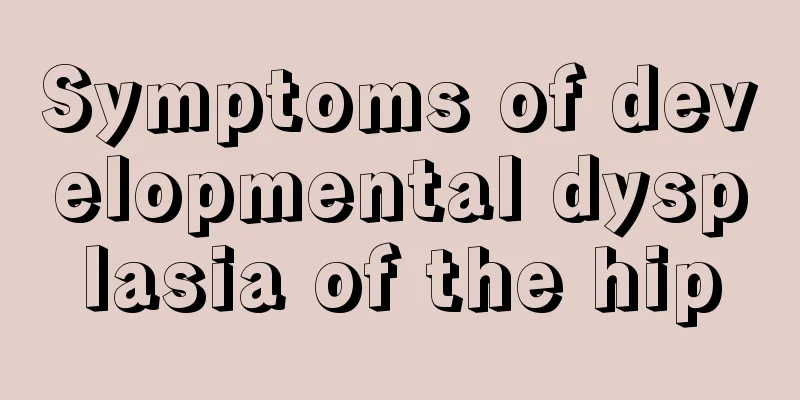Symptoms of developmental dysplasia of the hip

|
When many parents take their babies to the hospital for physical examinations, they will find that the doctor will look at the lines on the baby's buttocks. In fact, this is to check whether the baby suffers from congenital hip dysplasia. We all know that no matter what disease, early treatment is more effective. If the baby suffers from congenital hip dysplasia, it must be treated in time to avoid affecting the baby's future physical and mental health. Let's learn about the symptoms of congenital hip dysplasia. Congenital hip dysplasia is a gradually progressive disease with different anatomical and pathological changes in different age groups, most of which can be reversed in the early stages. However, if not treated promptly, the femoral head will shift proximally and laterally. This instability will lead to degenerative changes in the articular cartilage, which will become obvious in young adulthood and progress rapidly, turning into severe degeneration within a few years. The final pathological changes include subchondral sclerosis and cystic changes of the acetabulum and femoral head, osteophyte formation, and loss of articular cartilage. If treatment is performed in the early stages or surgery is performed to change the direction of the acetabulum and the force line of the joint, the progression of degeneration can be slowed down. Once severe degeneration occurs, if effective treatment is not given in the early stages, the condition will be irreversible. If it is not discovered or properly treated until school age, even though complex surgical treatments including pelvic osteotomy and femoral osteotomy can be used, it will be impossible to obtain a basically normal hip joint. This will seriously affect the appearance, gait, motor function, and social and psychological adaptability of children's lower limbs. If not treated or the treatment is ineffective, osteoarthritis will eventually occur at a very young age and hip replacement will have to be performed. There are several factors that predispose to developmental dysplasia of the hip: breech birth, oligohydramnios during the first pregnancy, torticollis, plantar adduction, left hip involvement more than the right, and postnatal banding of the newborn in an extended hip position (candle wrap). About 30% of children have a family history. In children of different age groups, congenital hip dysplasia has different clinical manifestations: 1. Neonatal period: increased skin wrinkles on the inner thighs or buttocks; limited hip abduction; joint clicking; unequal leg lengths or asymmetric buttocks. 2. Infancy: If the hip joint is no longer repositionable, corresponding special signs will appear: limited hip abduction, shortened thigh, upward displacement of the greater trochanter, asymmetric thigh skin lines, piston hip, and positive Galeazzi sign. 3. Children in the walking stage: For unilateral dislocation, the clinical signs are obvious: shortening and lameness of the affected limb, pelvic drop when the affected side bears weight, and the body tilts toward the affected side, that is, abductor muscle lameness or positive Trendelenburg test. Patients with bilateral dislocation present with bilateral limp gait, increased lumbar lordosis, pelvic descent during rest, and excessive internal or external rotation of both hip joints. 4. Imaging examination findings: Ultrasound: Ultrasound examination is only suitable for infants under 4 months old, and can be up to 6 months old; X-ray examination: The commonly used method is to take an AP radiograph of both hip joints, which can directly observe the relationship between the femoral head and acetabulum (X-rays are not recommended for children under 6 months old). Treatment principles for congenital hip dysplasia: The earlier the treatment, the more likely it is to eventually obtain a nearly normal hip joint. If diagnosed, treatment can be given immediately after birth. If the best time for treatment is missed, even with various treatments including complex pelvic surgery, a basically normal hip joint cannot be achieved. Parents can find clues of developmental hip dislocation/dysplasia from the following aspects: ① Asymmetric skin texture on the inner thigh and buttocks; ② Unequal width of buttocks; ③ Unequal length of lower limbs; ④ Positive abduction test; ⑤ Hip joint clicking; ⑥ Abnormal gait (duck walk); ⑦ Abnormal standing posture The people that every child comes into contact with the most every day are his or her parents. As a mother and a father, you must observe your baby's growth, development, and exercise more often, and consult a doctor in time if there are any problems. This will not only allow congenital hip dysplasia to be treated in time, but also other health problems encountered during the baby's growth can be treated in time, which is more conducive to the baby's healthy growth. |
<<: What to do if your child has a rash
>>: What to do if baby suddenly refuses to breastfeed?
Recommend
How to use medicine correctly for baby eczema
Infant eczema affects the baby's daily life, ...
What is the normal value of bilirubin in newborns?
The physical health of newborns is very important...
What should I do if my 3-year-old baby coughs?
Coughing is not a disease, but once it starts, it...
What is the reason why babies always have diarrhea?
Some newborn babies are prone to diarrhea. The st...
What is the reason for children's hunchback?
The problem of hunchback is very common in life a...
How to Conduct Neonatal Behavior Assessment
When newborns reach a certain age, they must go t...
What to do if your three-month-old baby has green poop
Every parent will be very happy and joyful watchi...
Baby expectorant diet
Many newborns suffer from coughing, and most of t...
How to treat vulvar eczema in children?
If a child has eczema on his vulva, the impact wi...
Nursing methods for children with acute rash
If a child has an emergency, treatment and nursin...
How much water should babies be fed?
Babies also need metabolism. In addition to feedi...
When should children be circumcised?
I believe that the foreskin problem is a disease ...
What causes baby's skin to turn yellow?
There are many reasons for the baby's skin to...
Motor speech disorders
When you go to the hospital to see a doctor, many...
Nursing methods for common diseases in children
Symptoms of pneumonia: The onset is generally acu...









